Want to do more business on TikTok? Wondering how to use it to sell more products or get more leads?
In this article, you'll learn how to use TikTok collection ads, dynamic showcase ads, and lead generation ads to boost your marketing and sales goals.

#1: Set Up Your TikTok Product Catalog as Soon as Possible
If you have a product-based business, getting a TikTok product catalog up and running will be a game-changer. This feature allows you to store information about the products you're planning to promote through your TikTok marketing. In short, it's going to make creating ads much more efficient.
Note: The Product Catalog feature is currently available only to managed accounts in certain markets and isn't readily accessible to everyone upon joining TikTok for Business.
If you have access, you'll be able to use your catalog to:
- Provide important product information: This includes product names, descriptions, prices, images, and anything else you feel is important for customers to know about your offerings.
- Manage your products: TikTok allows businesses to create product sets and automated rules to provide custom information regarding products.
- Create custom videos: Once you've added products to the catalog, you can use TikTok's video template or the dynamic video generator to create engaging videos to be used in your ads.
With a catalog in place, you'll be able to create TikTok collection ads and dynamic showcase ads, which allow you to feature specific products you've added to the catalog. The benefit is that the ad will display up-to-date information about the product including things like pricing, availability, and sizes.
Create Your Catalog
The first step is to log into your TikTok Ads Manager account. In your dashboard, click on Assets in the main navigation bar. Most accounts will only have access to the following assets: Event, Creative, Audiences, and Comments. Only once you've contacted a sales representative will you find the Catalog option here.

Once it's available to you and you've accessed this page, click the Create button. You'll be prompted to add information about your catalog and its products such as the industry, catalog name, catalog owner, default currency, and targeting location.
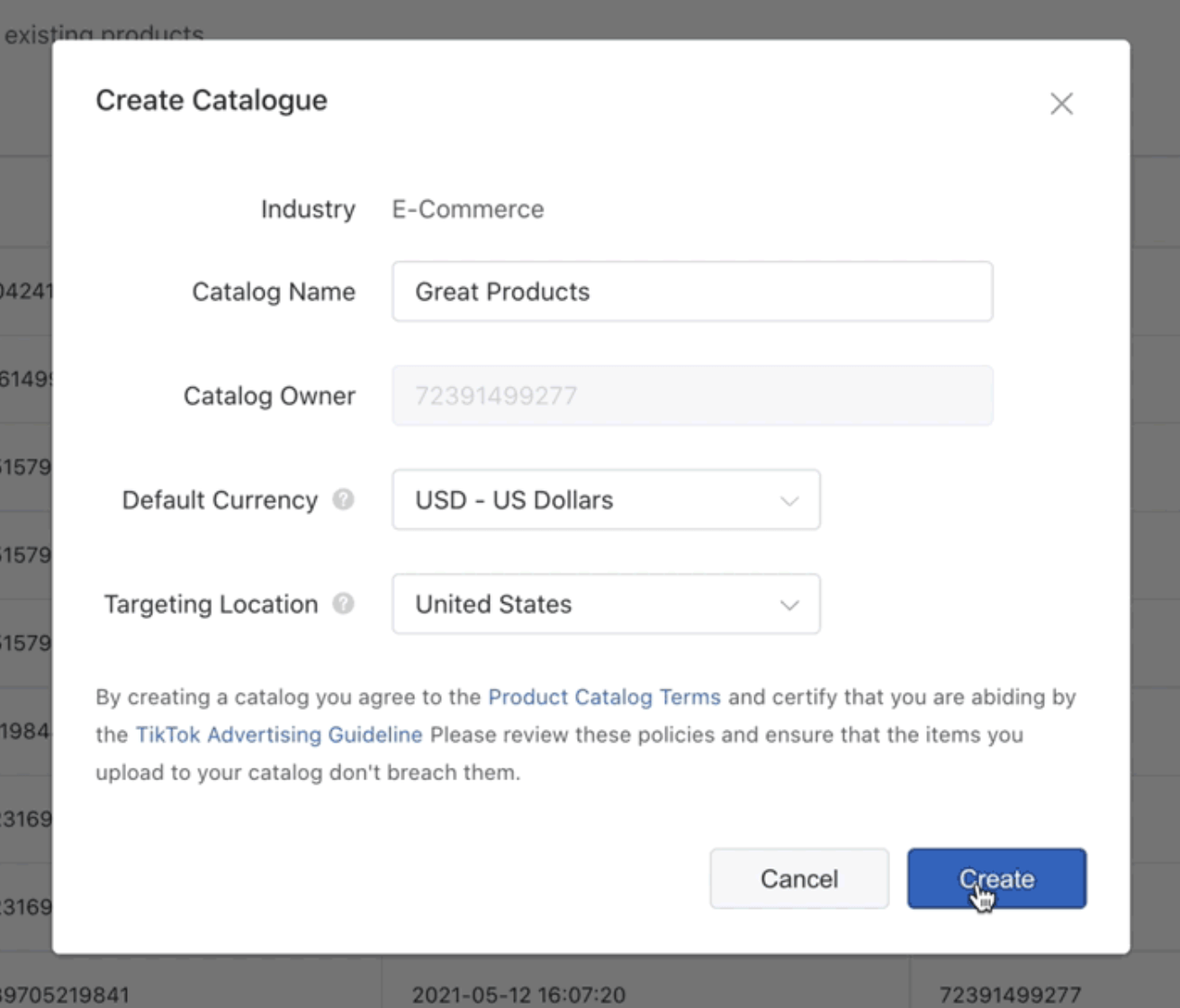
Add Products to Your TikTok Catalog
Now you're ready to start adding your products to the catalog, which allows you to create TikTok dynamic showcase ads. To do this, select the catalog you want to add products to via the catalog home page. In the left-hand menu, click on Products. Then click Add Products on the right.
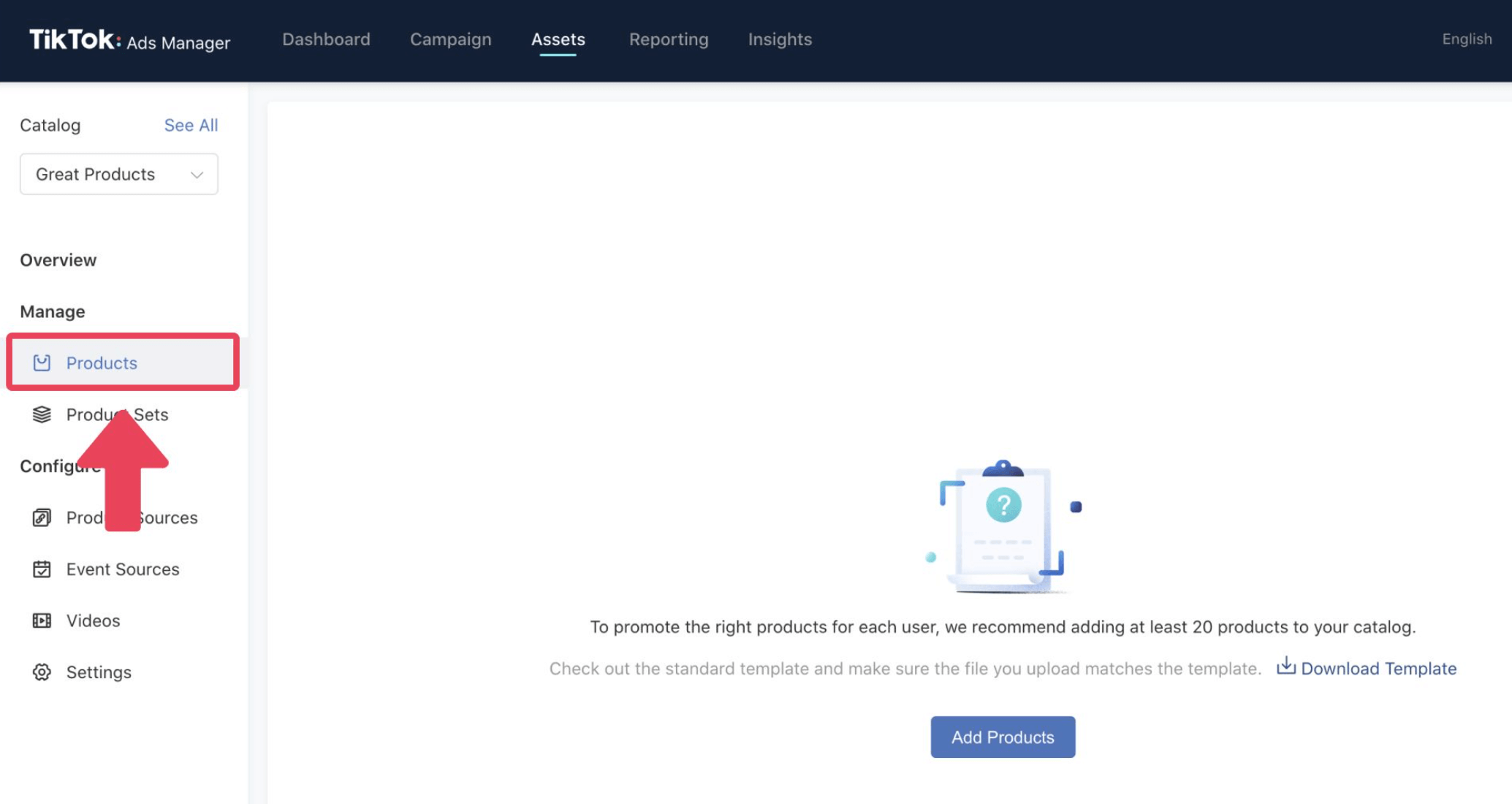
A pop-up will appear asking you to download a product template.
Get World-Class Marketing Training — All Year Long!
Are you facing doubt, uncertainty, or overwhelm? The Social Media Marketing Society can help.
Each month, you’ll receive training from trusted marketing experts, covering everything from AI to organic social marketing. When you join, you’ll also get immediate access to:
- A library of 100+ marketing trainings
- A community of like-minded marketers
- Monthly online community meetups
- Relevant news and trends updates
The template requires you to fill in nine specific parameters regarding your product. There are, however, 35 optional parameters you can add as well. The more details, the better, because it helps TikTok deliver personalized product recommendations. After this, you'll need to choose how you'd like to add products to your catalog.
TikTok provides you with three methods for adding products. You can choose to manually add your products by filling out a form, upload products from an online file, or use a template to upload product files. Choose whichever option is easiest for you.
#2: Create TikTok Collection Ads With or Without a Product Catalog
When the focus of your TikTok marketing is to drive viewers to take action, collection ads are a powerful option.
These ads are unique in that they include product cards that display during the in-feed video ad. Viewers can then tap on that card to be directed to an instant gallery page where they can browse and shop for available items without leaving the app. The ad type is ideal for boosting engagement, as well as conversions.

Collection ads are still in testing at the time of publishing this article so they aren't currently available for everyone. TikTok encourages users to contact a sales representative for more information. If you do have the ability to create these ads, the first step is to set up your product catalog as outlined above. After that, you can move to the next step below.
Create Your Campaign
Log into the TikTok Ads Manager and create a new campaign. When prompted to choose an advertising objective for this campaign, pick either traffic or conversions. With the traffic option, you can send people to your website or an app in the app store. Or you can choose to direct viewers to your website instead.

Next, create your ad group. You'll need to choose your website as the promotion type, add a tracking pixel, and select an optimization event. Under the Placement & Targeting section, you need to select the same location as your product catalog's targeting location. This is required.
Everything else on this page is under your control. You can set specific demographics (gender, age, and languages) and target specific interests, behaviors, and certain devices.
Next, complete the Budget & Bid Optimization section. Choose either a daily or lifetime budget (how much you're willing to spend per day or over the entire life of the ad), set a scheduled time for the ad to run, select an optimization goal, and set your bid.
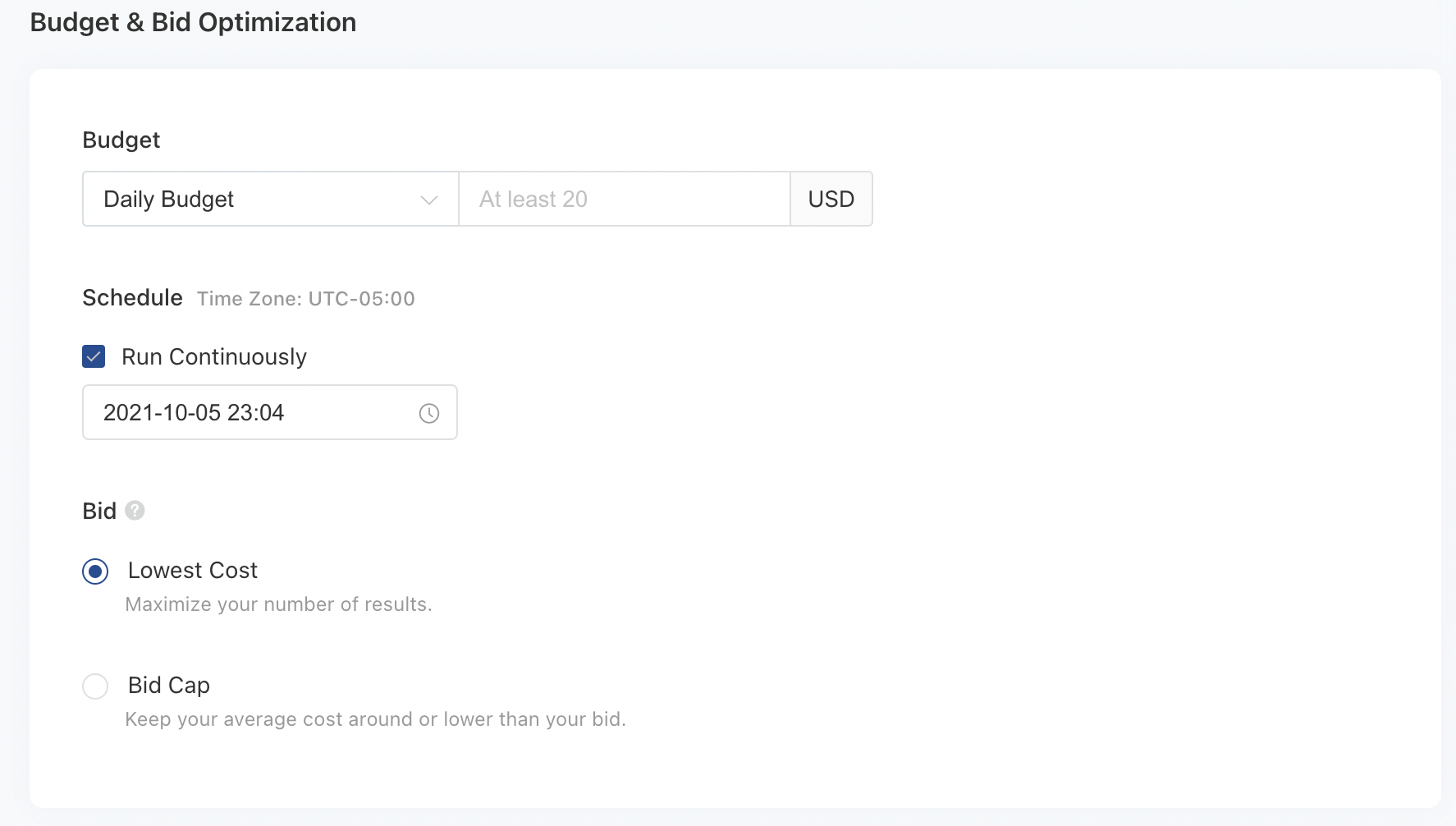
Create Your Ad and Build an Instant Gallery Page
After you've taken care of all of the back-end details, you're ready to create your ad. Under Ad Setup, select Use Recommended Combination as the ad format and Collection Ads as the attachment experience. From there, you can put in all of your ad details including uploading a video and adding a display name and ad text.
Click Create Instant Experience to access the Instant Gallery Page Editor to complete the next step, which is to create your instant gallery page. This page will present TikTok users with a gallery of products available for sale from your business. They can shop without having to leave the app, making it quick and easy to purchase.
There are two ways to build your gallery:
- Choose From an Existing Catalog: If you've already followed the steps above and created a product catalog, you can access it and select the products you'd like to feature. Once selected, you can choose your product order (Dynamic Order or Specific Order) and add a URL for your call to action (CTA).
- Manually Add Products: You can add product information in the Instant Gallery Page Editor if you haven't already added them via the catalog. This will require you to submit default currency, targeting location, and product information (image, name, price, URL).
Publish the Ad and Begin Ad Review
The last step is to publish your ad. Submit the ad to TikTok and it'll go under review.
It's important to note that collection ads are handled differently than other types of TikTok ads. Because collection ads are tied to your product catalog and instant gallery, every product in the catalog or gallery will go through the ads review process. This means it can take a little longer for your ad to be approved so keep that in mind if you're planning to run a time-sensitive ad during a launch.
#3: Create TikTok Dynamic Showcase Ads With a Product Catalog
If your TikTok marketing goal is to generate brand awareness, drive purchases, or boost app downloads, dynamic showcase ads can help. This ad type lets you promote multiple products to TikTok's users by way of personalized videos. With a suite of available templates to choose from, you can generate an ad that speaks directly to your target audience based on their interests and activities.

Discover Proven Marketing Strategies and Tips
Want to go even deeper with your marketing? Check out the Social Media Marketing Podcast! Publishing weekly since 2012, the Social Media Marketing Podcast helps you navigate the constantly changing marketing jungle, with expert interviews from marketing pros.
But don’t let the name fool you. This show is about a lot more than just social media marketing. With over 600 episodes and millions of downloads each year, this show has been a trusted source for marketers for well over a decade.

Dynamic showcase ads are available only for managed accounts in certain markets. Like the product catalog and collection ads, you'll want to contact a sales representative to learn more if it's something you're interested in creating for your business.
To create dynamic showcase ads, you'll first need to have followed the previously outlined steps for creating a catalog and adding products to it. That's because the videos you generate will be based on your existing catalog. Complete that step before moving forward to set up your campaign.
Create Videos for the Products in Your Catalog
To generate videos for the products in your catalog, access your product catalog, and under the Configure option, click on Videos. Select Dynamic Video Generator to begin creating your own unique videos, featuring effects, edits, and music that match the description of the products in your catalog.
You can create a maximum of seven videos per catalog at a time, which provides you with multiple videos to run as ads.
Connect Event Sources
Next, you need to connect your app measurement partner or TikTok pixel to your catalog so you can dynamically show ads to people based on in-app events or website interactions.
Navigate to your catalog in Ads Manager and click Event Sources on the left-hand side of the page. Choose from these two options:
- Select App Event Sources to track in-app events with TikTok's measurement partners.
- Select Pixel Event Sources to connect your product catalog with events that occur on your website. In this case, you'll need to set up a pixel within Ads Manager.

Create Your TikTok Dynamic Showcase Ad Campaign
Now you're ready to build your campaign. Head to the Campaign tab and create a new one. For the advertising objective, make sure you select Catalog Sales.

At the ad group level, there are a few specific options you'll need to select to set things up properly.
- Products: Choose your desired catalog and select a product set if you have one. Otherwise, all products will be selected by default. Then let TikTok know if your products are for sale via your website or an app.
- Targeting: Decide if you want to retarget your audience (allowing you to reach people who've already expressed interest in your website or app) or if you want to find prospective customers to reach new people. The latter will allow you to create a custom audience so you can target your ideal audience and exclude certain users.
The last step is to finalize the creative aspect of your ad. At the ad level, you'll need to do the following:
- Choose your video: If you've used the dynamic video generator, select the video you'd like to use for the campaign. If you have a video in your catalog under the Product Video URL parameter and want to use that instead, you can leave this blank.
- Decide your website type: To send traffic to a specific product page on your website, choose Product Link. Otherwise, you can select Custom Link to enter a unique URL. If you're selling via an app, choose Product Deeplink or Custom Link and select a Fallback Type in case the user doesn't have your app installed already.
Now you're ready to publish your campaign.
#4: Create TikTok Lead Generation Ads
For businesses on TikTok that want not only to reach a wider audience but also collect customer information, lead generation ads are the way to go. These ads display a CTA button at the bottom of the screen that prompts viewers to sign up or register for something.
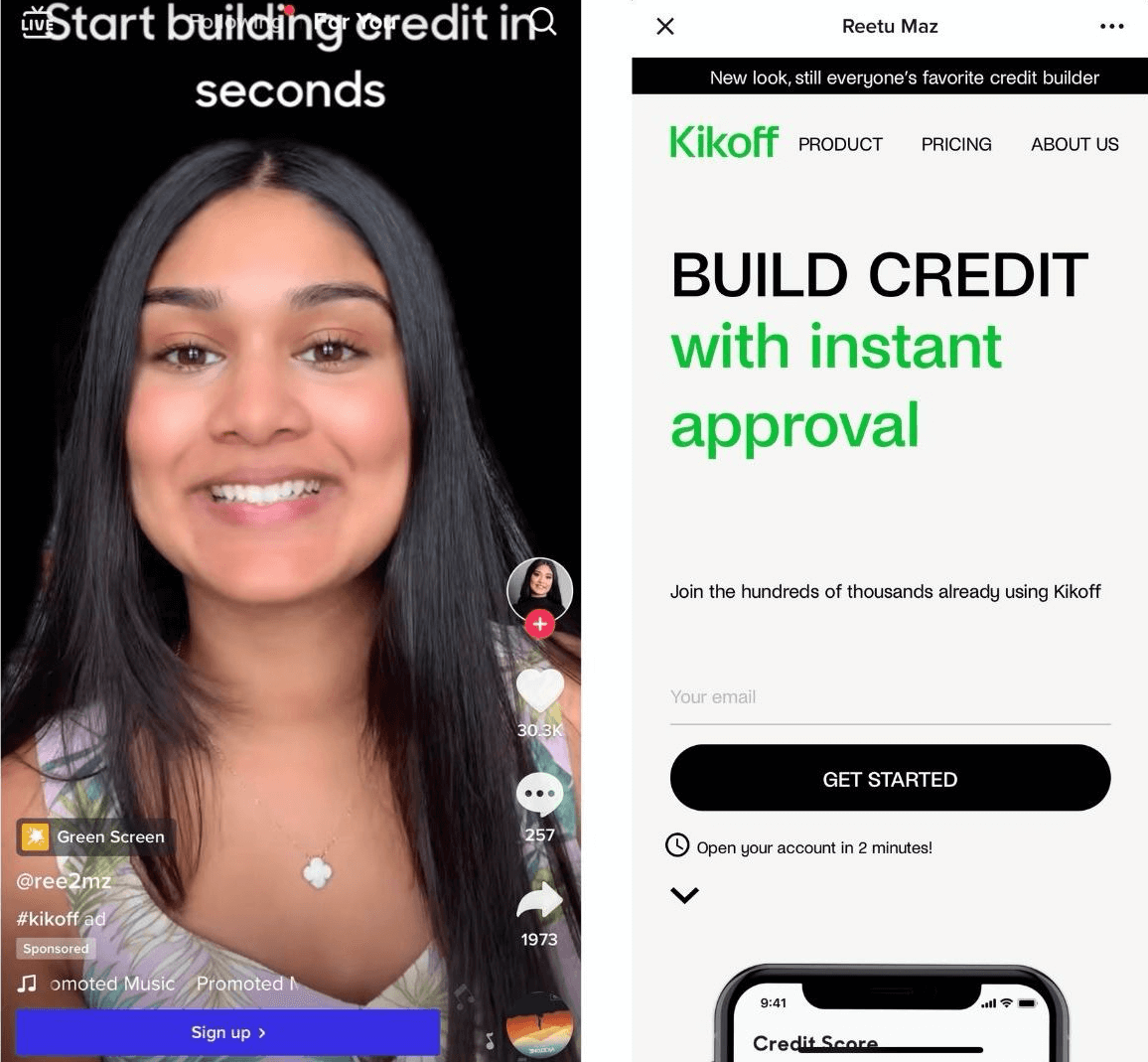
When users click through, they'll fill out a form where they can provide information such as their name, email address, and phone number.
Create a Lead Generation Campaign
To create a lead generation ad, start a new campaign from inside TikTok Ads Manager. When prompted to choose from the available advertising objectives, make sure you select Lead Generation. This will allow you to create an ad that's specifically designed to collect leads and customer data.

The next step is to fill out all of the information regarding your ad group. As you add this information, you'll notice a meter on the right-hand side of the screen changes to reflect the size of the audience you're targeting. This will help you see if your range is too broad or too narrow.
Next, create your ad group and select your placement, targeting, budget, and bid.
Under Placement Type, you can choose where you want your ads to appear and decide whether to turn user comments and video downloads on/off.

You can also specify which locations you'd like to target and the demographics of your desired audience (gender, age, and languages). If interested, you can take it a step further and target certain interests based on available categories and behaviors (such as video-related actions) and specific devices.
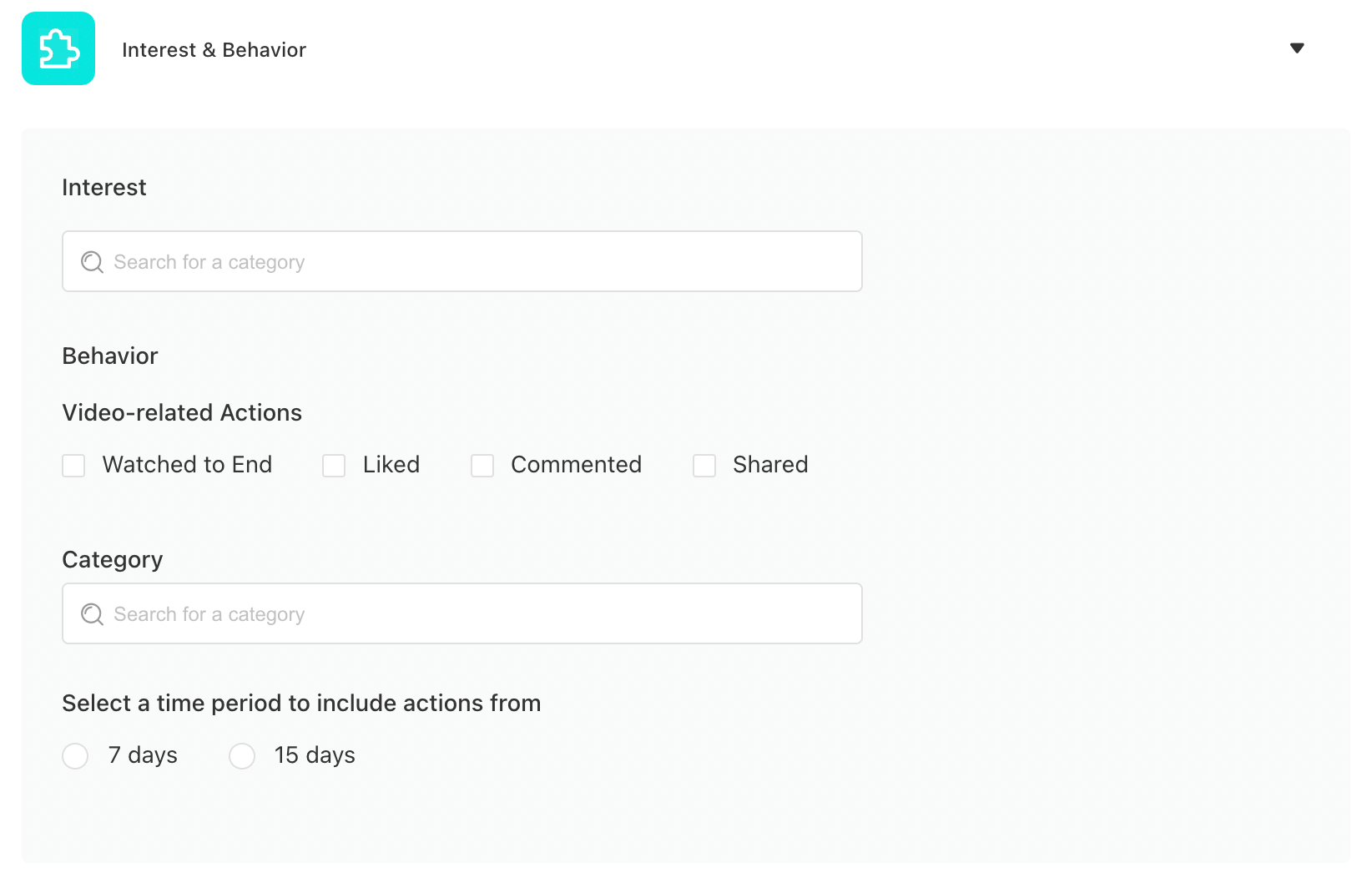
Under Budget & Bid Optimization, decide how much you want to spend on your ad. Do you want to go with a daily budget or a lifetime budget (the max spend for the life of your ad)? The daily budget must be at least $20, while the lifetime budget must be at least $7,300. When will your ad be live on TikTok? And when it comes to bid strategy, do you want to keep your average cost per result lower than your bid or maximize your number of results?
Design Your Lead Generation Ad
TikTok's lead generation ads are in the format of a single video. When a viewer interacts with your video, the form you've created during this step will instantly open so they can submit information like their name and email.
To create the ad, you'll want to upload a video, choose one from your library, or create a video using one of TikTok's templates.
From there, you'll need to add a display name, write creative text for your ad, and choose your CTA. TikTok has tons of CTA options, including Sign Up, Subscribe, Download, and Learn More. As you add all of these details, everything will appear in a preview so you can see exactly how it'll look when it runs on TikTok.
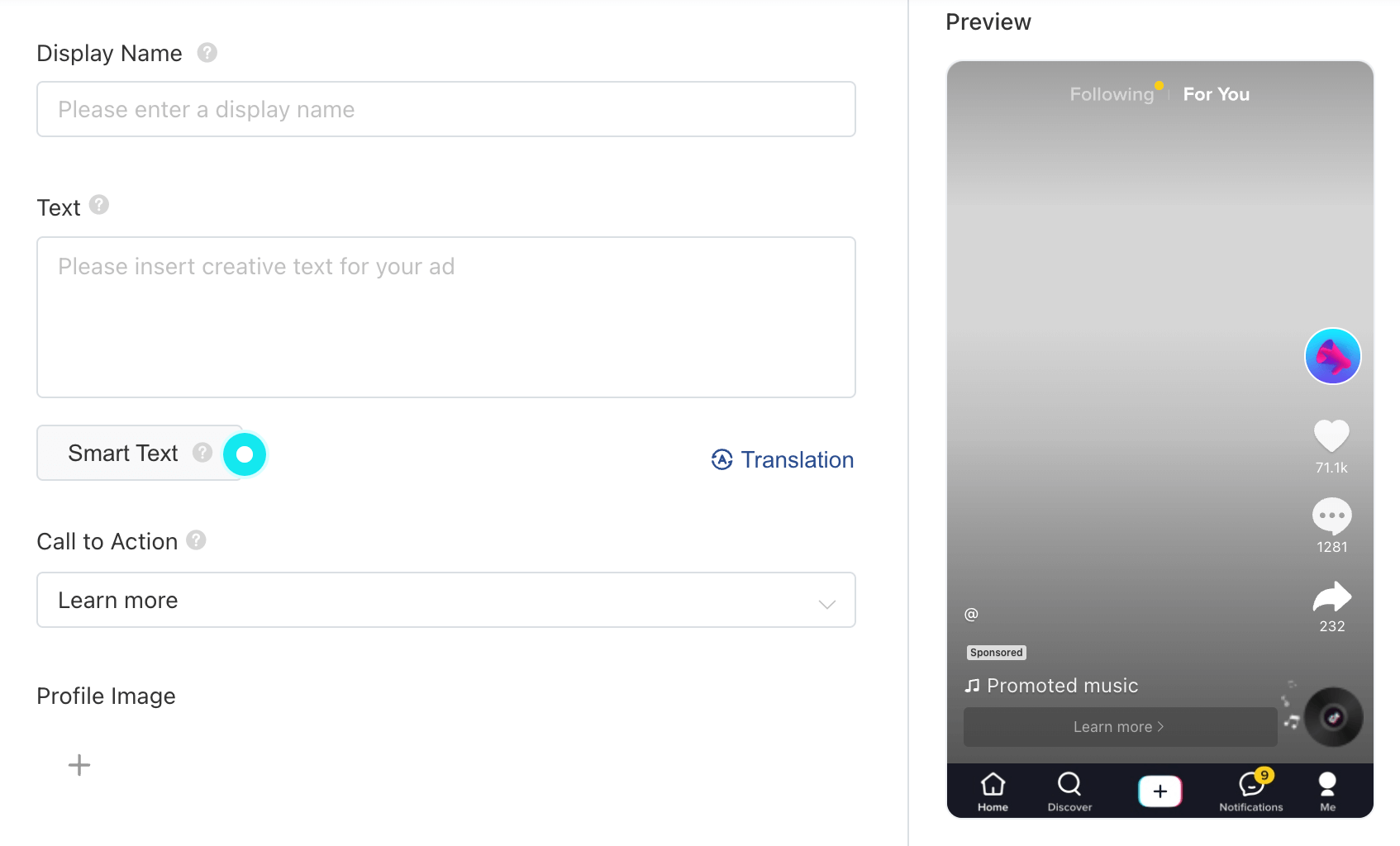
Next, you'll need to set up the all-important instant form. This is what pops up in an effort to collect lead data. There are currently two options for forms: Advanced Form (shown on the left in the image below) and Classic Form (shown on the right). If you're just looking to collect basic information like name and email, go with Classic. If you want to ask more questions, choose Advanced Form.

Should you want to add a third-party impression-tracking URL or a click-tracking URL, you can include those details before finally submitting your ad to TikTok.
Conclusion
It's not too late for your business to land a coveted spot on TikTok's For You page. Through the power of creative and engaging video ads, you'll be able to reach more people who are interested in buying your products and services to ultimately generate more sales.
Get More Advice on TikTok Marketing
- Amplify user-generated content with TikTok Spark ads.
- Use TikTok Promote to reach new audiences.
- Create a TikTok video that connects.
Attention Agency Owners, Brand Marketers, and Consultants

Introducing the Marketing Agency Show–our newest podcast designed to explore the struggles of agency marketers.
Join show host and agency owner, Brooke Sellas, as she interviews agency marketers and digs deep into their biggest challenges. Explore topics like navigating rough economic times, leveraging AI, service diversification, client acquisition, and much more.
Just pull up your favorite podcast app, search for Marketing Agency Show and start listening. Or click the button below for more information.

